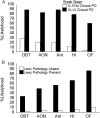Alpha-synuclein pathology in the olfactory pathways of dementia patients
- PMID: 17553102
- PMCID: PMC2375794
- DOI: 10.1111/j.1469-7580.2007.00748.x
Alpha-synuclein pathology in the olfactory pathways of dementia patients
Abstract
Lewy-type pathology is a characteristic of a number of neurodegenerative disorders, including Parkinson's disease and dementia with Lewy bodies. Thus far, the definitive diagnosis of these dementias can only be confirmed at post-mortem. However, it is known that the loss of smell (anosmia) is an early symptom in patients who develop dementia, and the use of the smell test has been proposed as an early diagnostic procedure. The aim of this study was to understand further the extent of Lewy pathology in the olfactory system of patients with neurodegenerative disorders. Post-mortem tissue from 250 subjects was obtained from the OPTIMA brain bank. Five areas of the olfactory pathway were examined by immunolabelling for alpha-synuclein - a major component of Lewy pathology: the olfactory tract/bulb (n = 79), the anterior olfactory nucleus in the lateral olfactory gyrus (n = 193), the region of olfactory projection to the orbito-frontal cortex (n = 225), the hippocampus (n = 236) and the amygdala (n = 201). Results show that Lewy pathology affects different parts of the olfactory pathways differentially, suggesting a specific pattern of development of pathology. Clinical Parkinson's disease is most likely to be identified if the orbito-frontal cortex is affected, while the diagnosis is less likely if the pathology is restricted to the olfactory bulb or tract. These results suggest that pathology in the olfactory bulb and tract occurs prior to clinical signs of Parkinson's disease. Furthermore, the results presented here provide further evidence supporting the possible value of a smell test to aid the clinical diagnosis of neurodegenerative diseases.
Figures




References
-
- Arendt T. Neurodegeneration and plasticity. Int J Dev Neurosci. 2004;22:507–514. - PubMed
-
- Arima K, Ueda K, Sunohara N, et al. NACP/alpha-synuclein immunoreactivity in fibrillary components of neuronal and oligodendroglial cytoplasmic inclusions in the pontine nuclei in multiple system atrophy. Acta Neuropathol (Berl) 1998;96:439–444. - PubMed
-
- Attems J, Quass M, Gartner W, et al. Immunoreactivity of calcium binding protein secretagogin in the human hippocampus is restricted to pyramidal neurons. Exp Gerontol. 2007;42:215–222. - PubMed
-
- Braak E, Braak H. Silver staining method for demonstrating Lewy bodies in Parkinson's disease and argyrophilic oligodendrocytes in multiple system atrophy. J Neurosci Meth. 1999;87:111–115. - PubMed
-
- Braak H, Del Tredici K, Rub U, de Vos RA, Jansen Steur EN, Braak E. Staging of brain pathology related to sporadic Parkinson's disease. Neurobiol Aging. 2003;24:197–211. - PubMed
Publication types
MeSH terms
Substances
LinkOut - more resources
Full Text Sources
Medical

